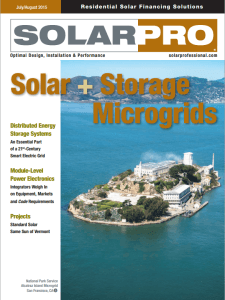Florida Solar Design Group’s Principal Solar Designer was asked to contribute to the July/August 2015 publication of SolarPro Magazine, the leading trade publication for solar professionals. In the article Integrator Perspectives on Module-Level Power Electronics, Szumlanski offered his perspectives and opinions on microinverters, which appear below as an except of the full article.
Module Level Power Electronics (MLPE) are devices that convert DC to AC electricity at the point of production (the solar panel) or optimize and monitor power output for each individual solar module. These are commonly known as microinverters and power optimizers, respectively.
Article Excerpt:
How would you characterize your experience with MLPE systems?
I have been selling Enphase microinverters almost exclusively since late 2009. We have designed and installed hundreds of residential and commercial systems. At one site, we have four buildings, each with 27 kW and totaling 108 kW. The largest single-building Enphase system we have designed is 43 kW.
In terms of annual installed system capacity, approximately what percentage of your installations use MLPE? How has this changed over time?
In 2009, the company I ran went from 100% string inverters to more than 95% microinverters overnight. A few customers still wanted string inverters for various reasons, and some modules we sold were not compatible with microinverters.
What version of the NEC is in effect in the regions your company serves? Have Code changes, such as Section 690.12, impacted your use of MLPE?
Florida is currently on NEC 2008. (Note that Florida has since changed to NEC 2011 and the response was submitted prior to the change)
How do MLPE products impact the cost of systems? Is there an effect on your cost of doing business? For example, do you realize increased sales, system design, inventory, installation or O&M efficiencies?
Sticking with one primary product greatly reduces procurement complexity, design work and stale inventory. While microinverters cost more on a dollar-per-watt basis, the advantages of streamlined operations nearly outweigh the additional costs. The advantages in terms of sales features easily overcome the price premium. Additionally, the peace of mind that module-level monitoring provides is valuable to system owners.
What are some primary sales, design or installation advantages of MLPE systems?
Module-level monitoring, diagnostics and repair are clear selling points. MLPE greatly simplifies design. For example, a single-line diagram can describe a wide range of microinverter system sizes when the contractor enters just a few parameters. This approach expedites the AHJ’s plan review, as the personnel reviewing drawings become comfortable with the standardized electrical schematics. Installation is somewhat streamlined. Simplifying the training of new employees is a key advantage.
What are some primary sales, design or installation limitations of MLPE systems?
The additional cost of microinverters puts installers at a slight competitive disadvantage compared to installers using string inverters. The competitive arguments against microinverters, including increased potential points of failure, can be a disadvantage at times. Consumers who are strictly price shoppers may not see the value in MLPE.
What has been your experience with the reliability of MLPE components? How does it compare to non-MLPE components or systems? Has your experience with MLPE reliability changed over time?
The Enphase M190 microinverter admittedly had a very high failure rate. Some of our systems required 100% replacements with either the same model or upgrades to the M215. Enphase has been proactive and generous in supporting its warranty on early models. The failure rate went to near zero with the introduction of the M215, with most failures occurring at or soon after installation. We have had essentially no failures of the Enphase M250.
String-inverter failure rates were also high for our clients, with some brands outperforming others. One brand in particular had a near 100% failure rate in less than 10 years. Other brands have been very solid, with near-zero failure rates. I would consider the new generation of microinverters to be as reliable as the best brands of string inverters, although only time will tell.
What advancements in MLPE components or systems would increase your use of these technologies?
Integrating monitoring into the MLPE would be a good idea. The monitoring gateway is a point of failure with a shorter warranty period that adds complexity to the system. Enabling microinverters to connect directly to existing Internet routers would be ideal. Alternatively, a lower-cost and simpler gateway device would be a good improvement.


